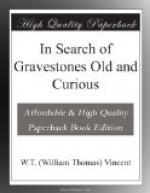Fig. 32.—At Horton Kirby.
“To John Davidge. died April
22, 1775, aged
75 years.”
[Illustration: Fig. 32. Horton Kirby.]
[Illustration: Fig. 33. Cliffe.]
In the second instance, at Cliffe, the inscription has been in great part obliterated by time, but the words written were evidently those of the chapter from Corinthians which is part of the Burial Service: “O death, where is thy sting? O grave, where is thy victory?” They are, however, almost illegible, and I have made no attempt to reproduce them in the picture.
Fig. 33.—At Cliffe.
“To Mary Jackson, died March 26, 1768.”
There is a second stone of similar pattern in Cliffe Churchyard, dated 1790. It differs from the foregoing only in having the spear broken. The sculptor of another specimen at Darenth, near Dartford, thought the subject worthy of broader treatment, and transferred it to a stone about double the ordinary width, but did not vary the idea to any great extent. Indeed, Horton Kirby and Darenth, being next-door neighbours, have most features in common; the falling tower, which symbolizes the Day of Judgment, appearing in both, while it is absent from the more distant examples at Cliffe and Newhaven. The introduction of the omniscient eye in the Cliffe case is, however, a stroke of genius compared with the conventional palm branches at Horton Kirby, or the flight through mid-air of the tower-tops both at Horton Kirby and at Darenth.
Fig. 34.—At Darenth.
“To John Millen, died June
11th, 1786, aged
82 years.”
Outside the county of Kent I have met with nothing of this pattern, and pictorial art on a similar scale is seldom seen on the gravestones anywhere. Specimens from Lee, Cheshunt, Stapleford Tawney, and elsewhere, will, however, be seen in subsequent pages.
The day of joyful resurrection is prefigured possibly in more acceptable shape in the next instance, no imitation of which I have seen in any of my rambles.
Fig. 35.—At Kingsdown.
“To Ann Charman, died 1793, aged 54 years.”
No one to whom I have shewn this sketch has given a satisfactory interpretation of it, but it will be allowed that the design is as graceful as it is uncommon. That it also in all likelihood refers to the Day of Judgment may perhaps be regarded as a natural supposition.




